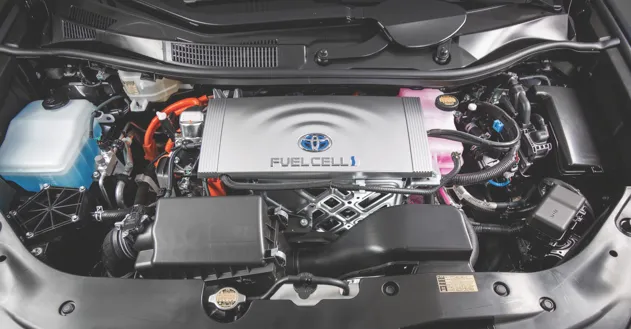At the turn of the millennium, Toyota introduced the world to the Prius - a hybrid car that paired an electric motor with a combustion engine. The Prius’s sales figures proved that there was an alternative to petrol and diesel cars, and that motorists were hankering after something a little kinder to the planet.
Today, nearly every car manufacturer, from Porsche to Peugeot, sells a hybrid model. So when Toyota described their latest car model as a 'turning point' in history, we thought that we ought to take a look.
This 'turning point' is called the Mirai – which means 'future' in Japanese – and it’s powered by hydrogen fuel cells. More precisely, its fuels cells use hydrogen and oxygen to create electricity, which then powers an electric motor hooked up to the wheels. The byproduct of this reaction is H20, so the only thing that will leave the car’s exhaust is steam. In terms of a successor to the traditional combustion engine, it sounds like a no-brainer, but there are still some hurdles in its way if it is to be a success.

Just like petrol, hydrogen is highly flammable. While the motoring industry has had the benefit of over 100 years of research and engineering to work out how to safely distribute, store, carry and use petrol, the hydrogen fuel cell industry is still in its infancy. But it’s not starting from scratch, as the idea of a hydrogen car has been around since the 1990s. Ever since then, Toyota claims that it has been testing the safest way to carry hydrogen around. The company’s solution is a carbon fibre fuel tank that’s incredibly solid and light. This tank is loaded with sensors that tell the car to isolate the hydrogen in an emergency. Given how strict the motoring industry is with safety standards, we’re willing to bet that hydrogen cars will be no more dangerous than their petrol equivalents. But hydrogen fuelling stations are another problem altogether.
Before buying a car, early adopters will need to know whether the country’s roads will be equipped with a fuel network that allows them to get around. Thankfully, that won’t necessarily mean a huge number of stations. The Mirai will have a range of 300km, which is almost enough to get you from London to Manchester in one trip. Compared to electric charging stations, only a relatively small number of hydrogen fuelling stations would be needed. In the US it looks like this won’t be a problem. There are already plans to create a chain of stations linking the east and west coasts of America. The goal is to have 46 US stations open by the time the car goes on sale at the end of 2015.
In the UK, the number of predicted stations is a less optimistic six. But Toyota, buoyed by Tesla’s success at installing a supercharger network across the US and UK, has few reservations that a hydrogen fuel network will pop up before long. Besides, Toyota is not alone - Honda and Hyundai are both launching hydrogen fuel cell cars too.
Ultimately, the Mirai isn’t about hydrogen fuel cells replacing the use of fossil fuels in cars (let’s not forget the majority of hydrogen comes from fossil fuels at the moment) or batteries, for that matter. As Toyota states, the idea is to diversify the types of fuel we use, so that our way of life isn’t dependent on one single fuel. Either way, there’s little doubt that hydrogen cars are rolling into town.
This preview first appeared in the February 2015 issue of BBC Science Focus.
Follow Science Focus onTwitter,Facebook, Instagramand Flipboard
